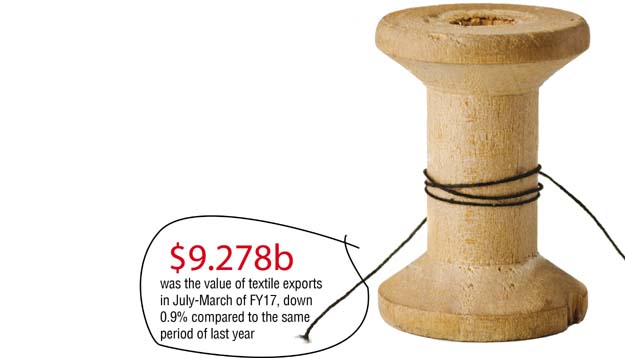Money borrowed by textile sector may be going to real estate
Despite growth in borrowing, textile exports continue to decline

Despite growth in borrowing, textile exports continue to decline. PHOTO: REUTERS
This has also caught the attention of the State Bank of Pakistan (SBP) governor, who has suggested that the money borrowed by the textile industry might be going to other profitable sectors like real estate or stock market.
“Borrowings of the textile industry are continuously growing, but textile exports are on the decline. I wonder where this cheap borrowing is going, maybe it is going to the real estate sector?” SBP Governor Ashraf Mahmood Wathra commented during his recent visit to the Karachi Chamber of Commerce and Industry (KCCI).
Planning Commission seeks Rs16.5b for 50,000 housing units
His concerns are not baseless. According to SBP data, the textile sector borrowed Rs123 billion in the second quarter (Oct-Dec) of the current fiscal year 2016-17, up 36% compared to Rs90.3 billion in the same period of previous year.

However, textile exports in the first nine months (July-March) of FY17 declined 0.9% to $9.278 billion compared to the same period of last year, according to latest available data of the Pakistan Bureau of Statistics (PBS).
The situation is similar in overall exports of the country. Pakistan’s exports in July-March fell 3% to $15.19 billion.
The central bank governor is of the view that the country needs a new breed of exporters because the current lot has lost the appetite to grow.
However, the exporters believe that the government as well as the SBP governor are unaware of the ground realities of export-oriented industries.
“The SBP governor does not know about the full chain of textile sector,” Pakistan Apparel Forum Chairman Muhammad Jawed Bilwani told The Express Tribune. “We want to talk to him (the governor) about our problems, but he never gave us meeting time.”
In January, Prime Minister Nawaz Sharif announced a Rs180-billion package for five major export-oriented sectors, including textile, to give a boost to the country’s exports. Leading textile exporters were hopeful that the package would help increase their exports, but it might take four to five months.
Black money in real-estate sector
Textile industry officials, especially those that are associated with garment manufacturing, say the textile sector can provide maximum number of jobs to the unemployed youth because it is a highly labour-intensive industry.
Textile exports constitute more than 60% of total exports of the country, therefore, successive governments have always been cognisant of its problems and provided it with different packages. But, like some other export sectors, Pakistan’s textile exports have literally been stagnant at levels where they were a decade ago.
“We have time and again warned the government that it is only the textile sector that can solve Pakistan’s economic problems,” emphasised Bilwani. The government can still help increase textile exports by supporting the finished goods or garment industry because it utilises minimum electricity, generates maximum number of jobs and earns highest profit margins in comparison to exports of unfinished products, he added.
Mian Kashif Ashfaq, CEO of ChenOne, one of the largest garment store chains in Pakistan, told The Express Tribune that the government is not releasing sales tax refunds of exporters as well as rebates due to which textile exporters are facing a severe liquidity crunch.
Meanwhile, energy crisis is still very much here and the textile industry is not getting enough electricity to meet export orders, said Ashfaq.
The government says textile exporters are incapable of meeting the requirements of modern trade. In contrast, the industry says the government is indifferent to the problems faced by them.
These are worrying signs for the economy because the textile sector, despite acquiring huge loans to invest in fixed assets, is not confident of increasing exports in coming months.
When this government came to power in mid-2013, it vowed to eliminate energy crisis by the end of its tenure in 2018. However, so far the claims of the government have been different from the ground realities.
Published in The Express Tribune, May 2nd, 2017.
Like Business on Facebook, follow @TribuneBiz on Twitter to stay informed and join in the conversation.


















COMMENTS
Comments are moderated and generally will be posted if they are on-topic and not abusive.
For more information, please see our Comments FAQ